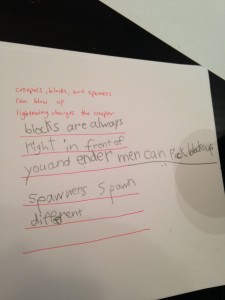“You will write if you will write without thinking of the result in terms of a result, but think of the writing in terms of discovery, which is to say that creation must take place between the pen and the paper, not before in a thought or afterwards in a recasting…It will come if it is there and if you will let it come.” Gertrude Stein
My second multimedia project for this course focuses on the process of poetic composition. I used Quicktime to screen capture my creative process as I wrote. When I showed this performance to my class they suggested that the poem might do well to be scored. I instantly thought of Mozetich’s “Postcards From the Sky” (look it up). So, as for my piece–watch it and consider having your ELA classroom experiment with their own performance poems. Don’t worry about a “rubric”. This is a process, remember? It’s all about feedback. Have a conversation about it. Have 3.
My performance can be seen here.
Incidentally, here is the process of an 8 year old in action writing about Minecraft and then drawing a picture inspired by her poem:




2 responses so far ↓
TMD // Jul 24th 2014 at 8:53 am
Dear Gunita,
As I observed in class, I think this approach is highly compelling and worth exploring further. It’s a form of kinetic poetry that invites viewers to engage in the process rather than product of writing. As such, my sense is that it has the potential to assuage students’ aversion to poetry — that is, to make it less monolithic and immutable as a literary form.
The notes you’ve provided don’t address all of the questions associated with this media project (see syllabus). Perhaps, in the spirit of having three conversations, you can add a comment below speaking to the merits and challenges of this exercise in the ELA classroom. (The questions were not all about rubrics and assessment.)
I’m wondering, as well, if you would be willing to have Ernesto or I experiment with uploading the video to YouTube such that it is not blurred when in full screen mode. It’s such a compelling approach — it would be excellent were the video clear for readers so that the impact is not diminished.
Thanks again for your contribution!
Best regards,
Teresa
gunitag // Jul 25th 2014 at 2:00 pm
Hi Teresa,
I would love for you and Ernesto to try to “fix” my video. I had to re-capture the image at 2x in order for it to be small enough to upload to YouTube.
Here is the rest of my assignment:
I think as an activity or exercise this sort of “experimental poetry” can have huge merits in the ELA classroom. For one, it can help to demystify poetry (a term I keep using) for those students who find it inaccessible and/or beyond their understanding. By engaging in a kinetic writing process–as you elegantly put it–students can visualize what actually happens when a person writes. Granted, it is just one vision of the process but it is more than most ever get to see. Students in any classroom are presented with exemplars that are final products. Rarely do they get the chance the see how such products are created.
Challenges-wise, the technology available in the school will be a factor in implementing this activity and it is somewhat difficult to implement without computers and a fast internet connection. That said, students might be able to use their devices to record a hand-written version of the same process in partners. A document camera could also be used to capture the process as completed by the class—which is an other way to create an exemplar as a group activity.
g.
You must log in to post a comment.